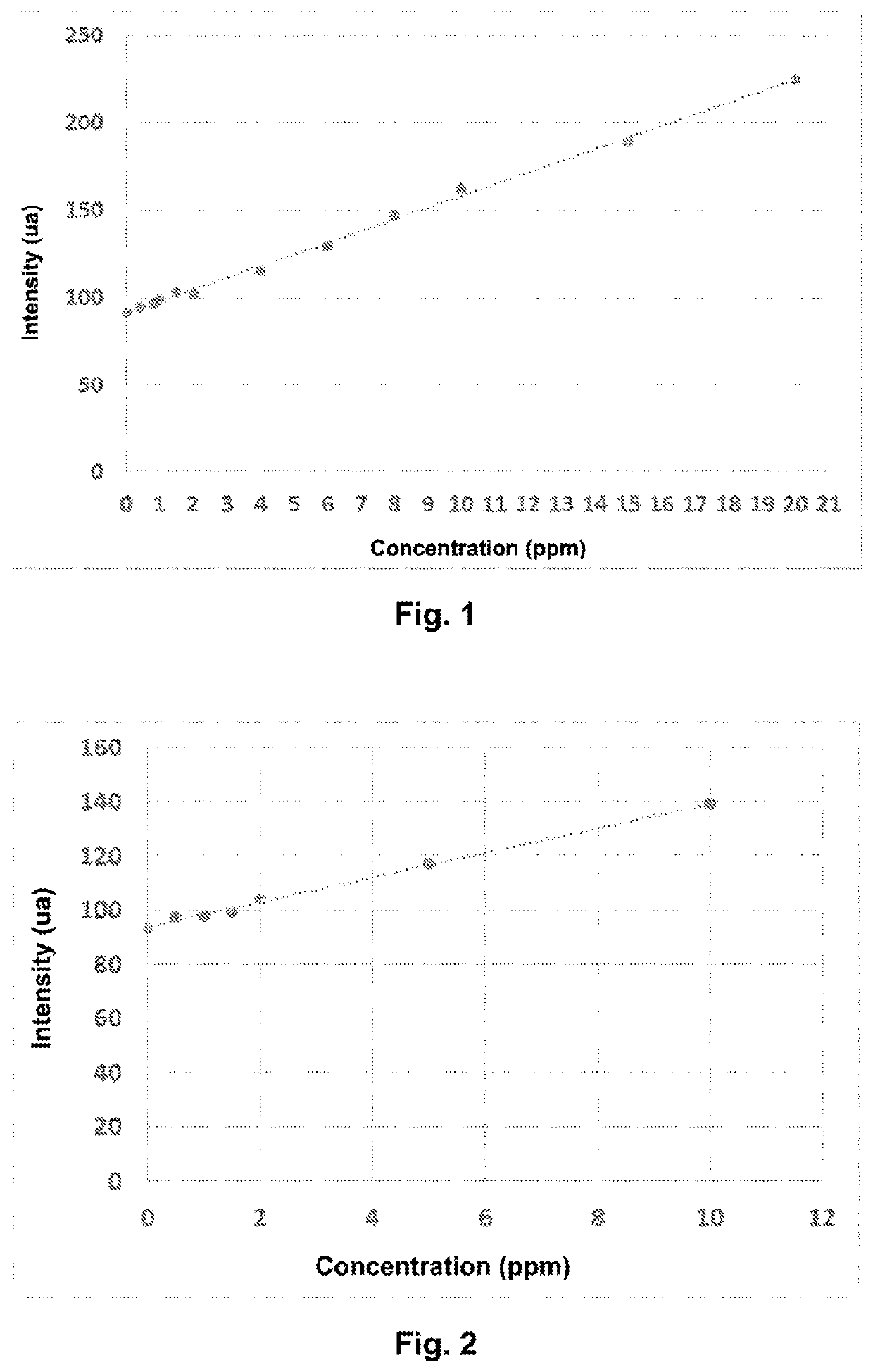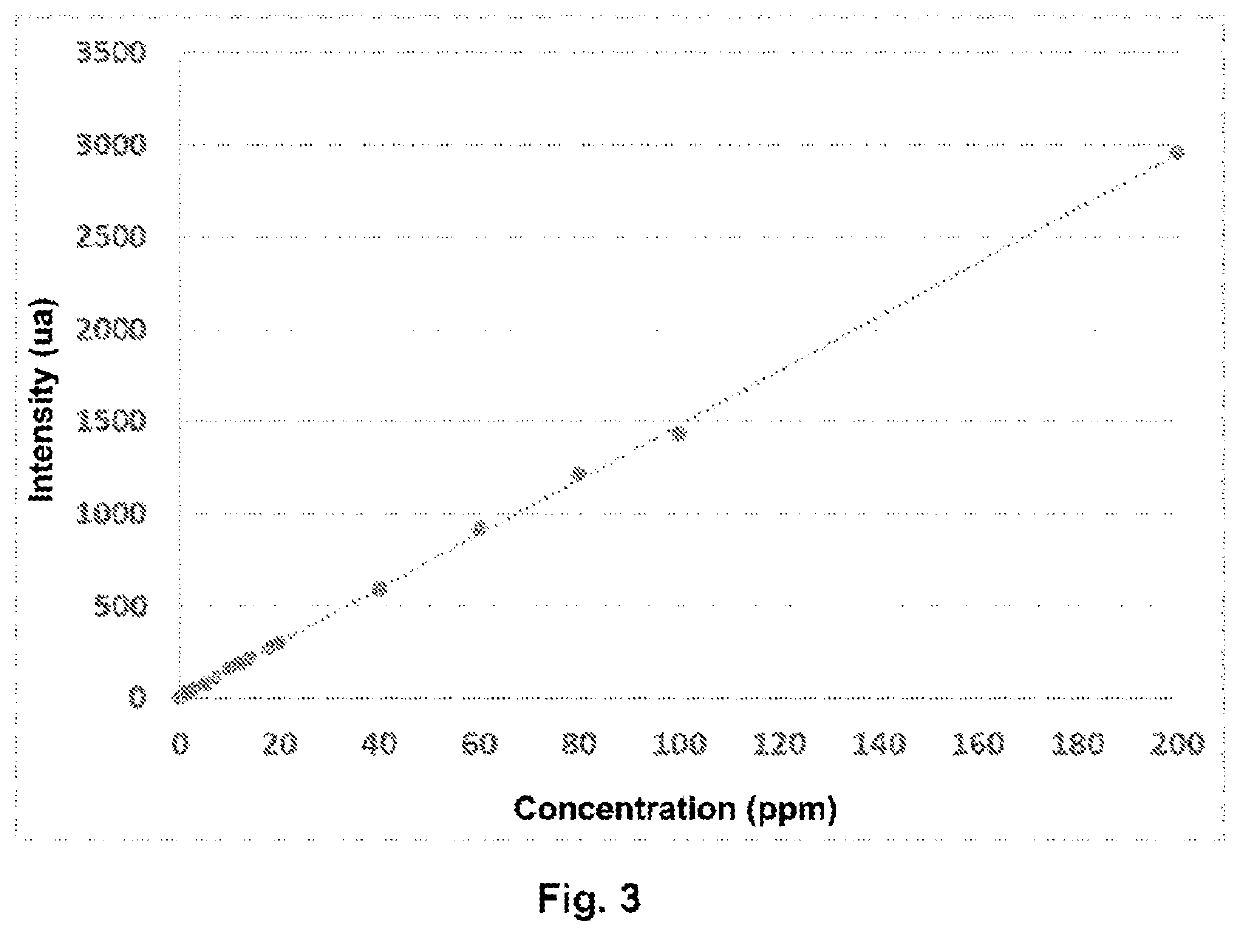Method for assaying cationic polymers by time-resolved photoluminescence
a cationic polymer and photoluminescence technology, applied in the direction of fluorescence/phosphorescence, testing water, instruments, etc., can solve the problems of changing the application performance, environmental problems and additional production costs, and restrictive methods, so as to reduce background noise.
- Summary
- Abstract
- Description
- Claims
- Application Information
AI Technical Summary
Benefits of technology
Problems solved by technology
Method used
Image
Examples
example 1
of the Residual Concentration of a Coagulating Cationic Polymer in Industrial Effluent Water
[0081]This example relates to the assaying of the residual concentration of a cationic coagulant of type poly(DADMAC), present in an industrial effluent water (conductivity of 385 μS.cm−1 at 20° C.).
[0082]a) Preparation of Control Solutions
[0083]Solutions of known concentrations were prepared of poly(DADMAC) (trade name: Floquat FL4440-SNF) by successive dilution of a stock solution of polymer with water having the same chemical salt composition as the industrial water (Table 1).
TABLE 1Concentration of control solutions of poly(DADMAC)Concentration (ppm, byweight relative to theReferenceChemical compositionweight of the solution)A0—0Alpoly(DADMAC)0.4A2poly(DADMAC)0.8A3poly(DADMAC)1A4poly(DADMAC)1.5A5poly(DADMAC)2A6poly(DADMAC)4A7poly(DADMAC)6A8poly(DADMAC)8A9poly(DADMAC)10 A10poly(DADMAC)15 A11poly(DADMAC)20
[0084]The characteristics of the dilution water are:
[0085]Iron concentration: 103 μg / l...
example 2
Assay of a Cationic Polyamine in Industrial Aggregate Wash Water
[0113]This example relates to the assaying of the residual concentration of a cationic coagulant of type poly(quaternary amine) present in industrial water from aggregate washing.
[0114]a) Preparation of Control Solutions
[0115]The following solutions of different concentrations are prepared by successive dilution of a stock solution of poly(cationic amine) (trade name: Floquat FL2250-SNF) with water having the same salt and conductivity characteristics as the produced water.
TABLE 2Composition of the control solutions of poly(cationic amine)Concentration (ppm, byweight relative to the weightReferenceChemical compositionof the solution)B0—0B1poly(cationic amine)0.5B2poly(cationic amine)1B3poly(cationic amine)1.5B4poly(cationic amine)2B5poly(cationic amine)5B6poly(cationic amine)10
[0116]The characteristics of the dilution water are:
[0117]Conductivity: 504 μS.cm−1
[0118]Iron concentration: 185 μg / l
[0119]b) Complexation with ...
example 3
Assay of a Flocculating Copolymer in Water Resulting from Industrial Sludge Flocculation
[0142]This example relates to the assaying of the residual concentration of a cationic flocculant of type poly(AM-co-ADAME quat) with a very high weight-average molar mass present in industrial water resulting from the flocculation of industrial sludge from a purification plant.
[0143]a) Preparation of Control Solutions
[0144]The following solutions of different concentrations are prepared by successive dilution of a stock solution of poly(AM-co-ADAME quat) (trade name: Flopaam FO 4650 SSH-SNF) with water having the same salt and conductivity characteristics as the produced water.
TABLE 3Composition of the control solutions of poly(AM-co-ADAME quat)Concentration (ppm, byweight relative to theReferenceChemical compositionweight of the solution)C0—0C1poly(AM-co-ADAME quat)0.5C2poly(AM-co-ADAME quat)1C3poly(AM-co-ADAME quat)2C4poly(AM-co-ADAME quat)3C5poly(AM-co-ADAME quat)5C6poly(AM-co-ADAME quat)7C7p...
PUM
 Login to View More
Login to View More Abstract
Description
Claims
Application Information
 Login to View More
Login to View More - R&D
- Intellectual Property
- Life Sciences
- Materials
- Tech Scout
- Unparalleled Data Quality
- Higher Quality Content
- 60% Fewer Hallucinations
Browse by: Latest US Patents, China's latest patents, Technical Efficacy Thesaurus, Application Domain, Technology Topic, Popular Technical Reports.
© 2025 PatSnap. All rights reserved.Legal|Privacy policy|Modern Slavery Act Transparency Statement|Sitemap|About US| Contact US: help@patsnap.com


